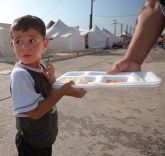×


We have detected your country as:
Please click here to go to the USA website or select another country from the dropdown list.
by: Joshua Spurlock, The Mideast Update
 A rebel of the Free Syrian Army stands amidst devastation in Aleppo, Syria. Photo: Dona Bozzi /shutterstock.com The sheer numbers in the Syrian civil war are staggering: more than 200,000 are dead according to a report backed by the United Nations; more than 3 million have become foreign refugees; and 10 million in total have been displaced. And these numbers only tell part of the story.
A rebel of the Free Syrian Army stands amidst devastation in Aleppo, Syria. Photo: Dona Bozzi /shutterstock.com The sheer numbers in the Syrian civil war are staggering: more than 200,000 are dead according to a report backed by the United Nations; more than 3 million have become foreign refugees; and 10 million in total have been displaced. And these numbers only tell part of the story.
The conflict has re-introduced chemical weapons into modern warfare, led to the rise of some of the worst terrorists in history, and bled into a regional war involving more than half a dozen different countries. It has likely even impacted the country you call home. In short, the Syrian civil war has become one of the worst conflicts in the last fifty years and much of the blame falls on Syrian President Bashar al-Assad and his allies in Iran.
The war, which has lasted roughly four years after it began as government repression of peaceful protests, has produced a long list of war crimes. Bombing civilian neighborhoods, torture, sexual assault and the use of the chemical weapon Sarin are among the atrocities believed to have been committed by the Syrian regime alone. On the other side, the Al-Qaeda spinoff Al-Nusra Front and the even more terrifying ISIS—also known as Islamic State or ISIL—have added beheadings, suicide bombings and more to the tragedy, according to media sources such as The Telegraph.
The situation is so bad in Syria that the life expectancy in the country has dropped roughly 20 years from an average of 76 years to just 56 years, according to the UN-supported report from the Syrian Centre for Policy Research. If its effect on Syrian citizens was the total impact of Mr. Assad’s war—which he instigated against the protesters so he could stay in power—it would be enough. But sadly, there’s still more.
As the Syrian regime began wobbling in the face of a fierce rebel struggle, Iran and its proxy Hezbollah in Lebanon began to step up assistance to Syria’s war machine, eventually openly sending military personnel and militants to back the Syrian army. Reports have also emerged that Israel prevented Syria from delivering advanced weaponry to Hezbollah terrorists by striking targets inside Syria, as the Assad regime sought to share with its terrorist ally. It didn’t take long before this internal repression was a regional conflict.
 Syrian boy in a Turkish refugee camp
Syrian boy in a Turkish refugee camp
Photo: Dona Bozzi/shutterstock.com Turkey has taken its own share of shelling and other threats from across the Syrian border and has fired back on occasion. Lebanon has turned into a secondary war zone in the Syrian conflict, as terrorists opposing the Syrian regime have attacked targets inside Lebanon in retaliation for Hezbollah’s involvement. That doesn’t even count the incredible refugee burden placed on Lebanon, Turkey and Jordan as terrified Syrians fled to the neighboring nations.
Then, there is the regional nightmare of ISIS. Bred in the Syrian battle, the extremist terror group conquered regions of Syria and moved into Iraq which led to an international military intervention whose goal was to prevent the psychopathic group from establishing a new Islamic empire, or caliphate. The terrorists’ success in Syria and Iraq has only emboldened ISIS, who also is reported to be in Libya as well…and even in Europe and beyond.
The United States has blamed the Assad regime for inspiring the rise of ISIS, even though the group is opposed to the regime. In media comments released by the State Department earlier this year, US spokesperson Jen Psaki has said the best “recruiting tool” for ISIS is the “brutality of the Assad regime.” Her colleague Samantha Power, US Ambassador to the United Nations, also laid the blame on the regime. “The rise of these violent extremist groups in Syria would not have happened without the atrocities perpetrated by the Assad regime,” said Power in comments released by her office.
But the subject of ISIS hasn’t just been heard in the speeches of officials from the West—members affiliated with the group have been physically present in those countries as well. Terrorists claiming allegiance to ISIS have carried out attacks in Europe, while ISIS has even reached Australia and Canada. Their success in oil-rich areas of Syria and Iraq has been more than just a recruiting springboard. The Guardian reported last November that a US official estimated ISIS was taking in “several million dollars per week from the sale of stolen and smuggled energy resources.”
 Young victims of a chemical attack
Young victims of a chemical attack
Photo: wikipedia.org And while ISIS is pulling in money to bring the Syrian conflict into Europe, North America and beyond, the West is spending hundreds of millions of dollars dealing with the aftermath of the Syrian civil war. A factsheet released from the European Commission called the conflict the “world’s largest humanitarian crisis since World War II,” noting the European Union and its member states have mobilized over 3 billion euros for the crisis in Syria and to deal with the Syrian refugee situation in neighboring nations. As of March, the US has given more than $3.1 billion to the humanitarian crisis as well, according to US Deputy Ambassador to the UN Michele J. Sison in comments released by the US Mission to the UN.
In total, the Syrian civil war has cost more in blood and cash than the rest of the world can afford to ignore. It’s not just a conflict “over there,” but it’s part of a new era of conflicts that deserve global attention. Mr. Assad and his Iranian allies fueled this terrible war to retain control of Syria, and much of the world has had to pay for their misdeeds.
All logos and trademarks in this site are property of their respective owner. All other materials are property of Bridges for Peace. Copyright © 2025.
Website Site Design by J-Town Internet Services Ltd. - Based in Jerusalem and Serving the World.